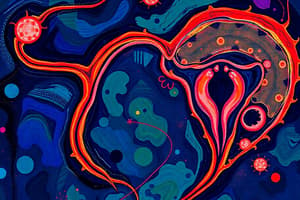Podcast
Questions and Answers
During oogenesis, what happens to the polar bodies after their formation?
During oogenesis, what happens to the polar bodies after their formation?
- They develop into fully grown oocytes
- They undergo further cell divisions
- They degenerate shortly after their formation (correct)
- They are reabsorbed by the ovary
What is the key difference between oogenesis and spermatogenesis in terms of the meiotic divisions?
What is the key difference between oogenesis and spermatogenesis in terms of the meiotic divisions?
- Oogenesis has two consecutive meiotic divisions, while spermatogenesis has only one
- Both oogenesis and spermatogenesis have two consecutive meiotic divisions (correct)
- Spermatogenesis has two consecutive meiotic divisions, while oogenesis has only one
- Both oogenesis and spermatogenesis have only one meiotic division
What is the purpose of the chiasmata that form during Meiosis II in oogenesis?
What is the purpose of the chiasmata that form during Meiosis II in oogenesis?
- They connect the homologous chromosomes during Meiosis I
- They provide additional genetic diversity by crossing over
- They ensure equal segregation of sister chromatids
- They allow the unequal spindles to pull the sister chromatids apart (correct)
What is the ultimate fate of the secondary oocyte produced during oogenesis?
What is the ultimate fate of the secondary oocyte produced during oogenesis?
What is the key difference between oogenesis and spermatogenesis in terms of the number of gametes produced?
What is the key difference between oogenesis and spermatogenesis in terms of the number of gametes produced?
What is the primary difference between the timing of oogenesis and spermatogenesis?
What is the primary difference between the timing of oogenesis and spermatogenesis?
During oogenesis, how many polar bodies are produced?
During oogenesis, how many polar bodies are produced?
Which of the following statements about spermatogenesis is true?
Which of the following statements about spermatogenesis is true?
What is the main difference between oogenesis and spermatogenesis?
What is the main difference between oogenesis and spermatogenesis?
During oogenesis, when does meiosis I and II occur?
During oogenesis, when does meiosis I and II occur?
What is the purpose of the large haploid oocyte produced during oogenesis?
What is the purpose of the large haploid oocyte produced during oogenesis?
Which of the following processes involves the separation of homologous chromosome pairs?
Which of the following processes involves the separation of homologous chromosome pairs?
Flashcards are hidden until you start studying
Study Notes
Oogenesis and Spermatogenesis
Oogenesis and spermatogenesis are two distinct processes in which mature gametes, egg cells (oocytes) and spermatozoa, respectively, are produced. These processes occur during development of an individual's reproductive system from its early embryonic stages until adulthood, and they require specific cellular mechanisms and interactions between germ cells and somatic cells within gonads. Both meiosis I and II are necessary to produce haploid gametes from diploid germ cells through these processes. In oogenesis, the first polar body is nonfunctional and degenerates, while in spermatogenesis, both polar bodies develop into functional daughter cells. Let's explore how these processes work in detail:
Oogenesis
Oogenesis takes place primarily during fetal development and continues until puberty, when the mature egg cell (oocyte) is released from the ovary, often called ovulation. During oogenesis, one primary oocyte undergoes two rounds of meiosis. Both meiosis I and II occur synchronously, meaning they begin simultaneously but do not divide equally. This creates a large haploid oocyte with multiple organelles and cytoplasm carrying essential nutrients for future embryonic growth.
Meiosis I in oogenesis involves homologous chromosome pair separation, followed by cell division, forming secondary oocytes and polar bodies. Homologous chromosomes separate before the spindle fibers attach to the centrosomes, which allows for proper segregation of genetic material. Secondary oocytes contain a single set of chromosomes, while polar bodies receive the remaining half of the original genome, which usually degenerate shortly after their formation.
During the second meiotic division (Meiosis II), the separating sister chromatids of the same chromosomes remain connected by chiasmata, accompanied by unequal spindles that pull only the sister chromatids apart. As a result, the secondary oocyte receives a full complement of chromosomes, while the polar body remains unreduced but highly condensed. The secondary oocyte grows gradually during the maturation phase, eventually becoming a fully grown oocyte that can be fertilized.
Spermatogenesis
Spermatogenesis occurs continuously throughout life, starting in early childhood and occurring mainly in the testes. Like oogenesis, spermatogenesis consists of two consecutive meiotic divisions (meiosis I and II). However, unlike oogenesis, both meiosis I and II progress sequentially, leading to four haploid spermatozoa from one diploid spermatocyte.
Meiosis I in spermatogenesis involves homologous chromosome pair separation followed by cell division, forming four daughter cells with each receiving a single set of chromosomes. Afterward, one half of these cells degenerate, leaving spermatids that will undergo Meiosis II. During Meiosis II, sister chromatids separate, leading to four haploid daughter cells. These four haploid cells divide mitotically, giving rise to eight fully developed spermatozoa.
Conclusion
Oogenesis and spermatogenesis are essential processes for the production of gametes, which are crucial for reproduction and species survival. While oogenesis occurs primarily during fetal development and ceases once maturity is reached, spermatogenesis continues throughout life, providing ongoing production of spermatozoa. Both processes utilize meiosis to reduce genetic materials, ensuring genetic diversity among offspring. Understanding these mechanisms contributes to our overall comprehension of reproductive physiology.
Studying That Suits You
Use AI to generate personalized quizzes and flashcards to suit your learning preferences.




